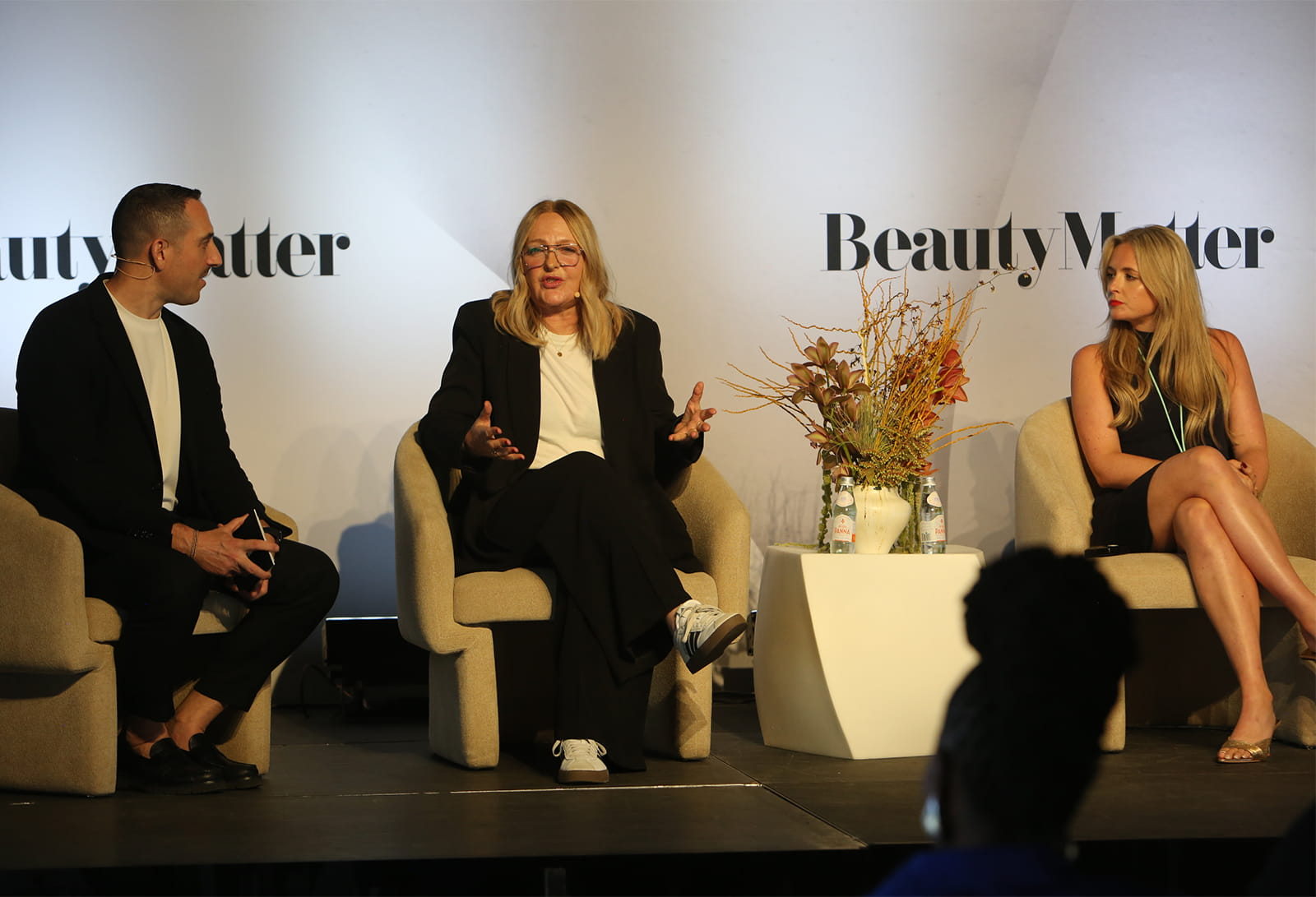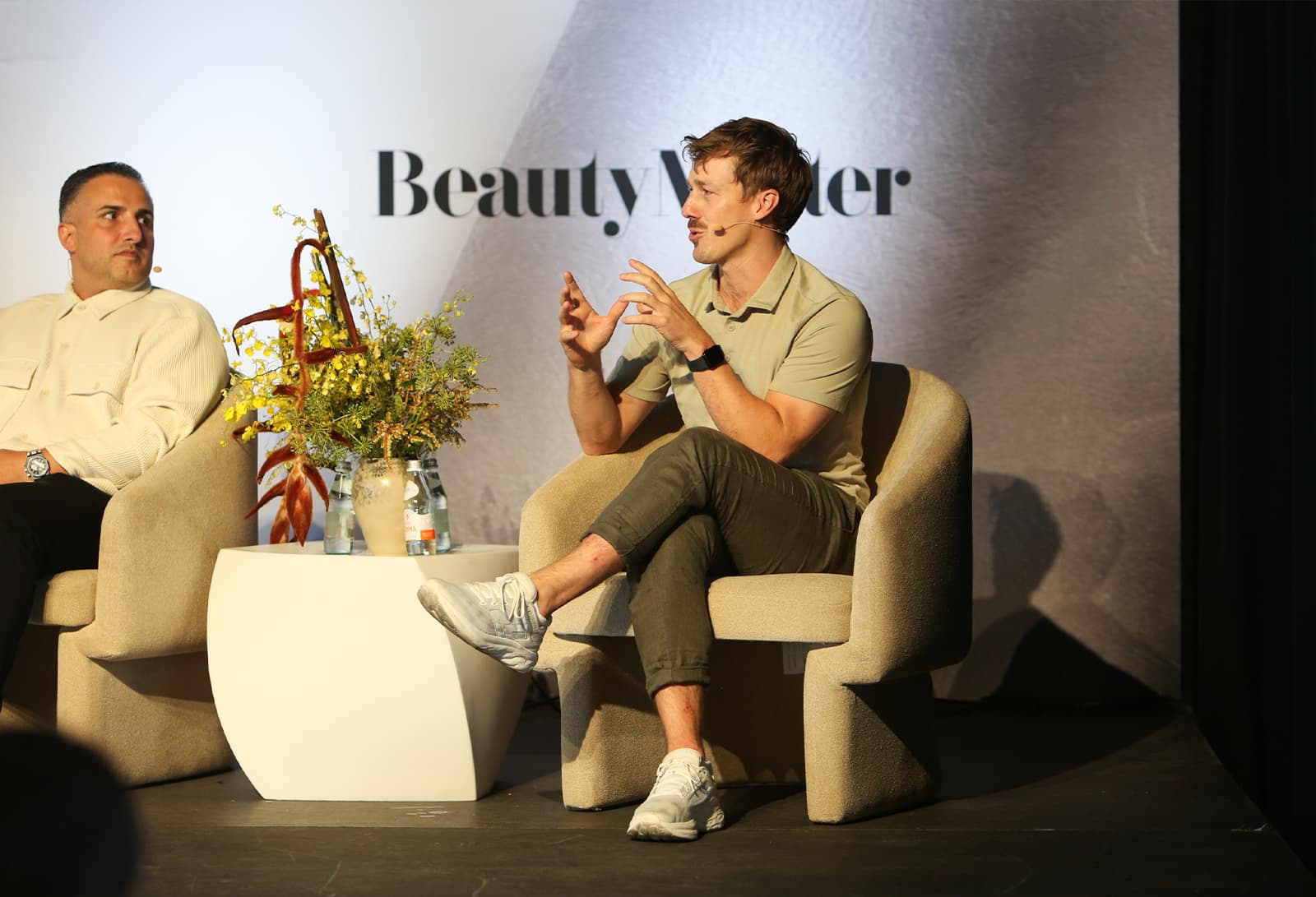As in industry constantly propelled forward by newness, disruption is the magic ingredient in the beauty industry’s recipe for success. It can take many forms from a new molecule to carving out a new niche in an existing category. Focusing on founders who identified a market gap hiding in plain sight, John Cafarelli, President and co-founder of BeautyMatter, sat down with Michele Gough-Baril, founder and Chief Brand, Product Officer of Iris&Romeo; David Gaylord, CEO of Bushbalm; Katy Cottam, founder and CEO of Luna Daily; and David DiLorenzo, founder and CEO of V Beauty Pure to discuss their why’s and how’s of shaking up the beauty industry.
Gough-Baril, who has been in the industry for two decades, expressed her frustration that “nobody was talking to women like me. Women who were over 40, who had busy, modern lives. We were being sold 10-step routines, fast beauty; it was this whole issue of excess. I was in a totally different place in my life where I wanted to really simplify and pare down. And I was aging. I needed things that worked for my skin.”
She set up Iris&Romeo on the premise of formulating for drier, aging skin, multipurpose products, and marketing towards older millennial and Gen X women who have a “less is more” approach to life. Gaylord, an outsider to the beauty category, was inspired to start Bushbalm upon seeing the lack of innovation in hair removal at his local hometown pharmacy.
“Over the years, a lot of categories had changed; the only one that didn't was the hair removal. You would see a product that was made in 1985, and it's still the same formula. It's alcohol based, it's horrible. If you look at the packaging, you would go, it's pretty obvious somebody needs to do something here. At first, we didn't say we're going to disrupt, we just naturally fell into this place,” he recalls. The brand’s partnership with Ulta Beauty also helped push this disruption along.
Cottam, whose brand has only been in the market for two and a half years, recounted how her own struggles with shame around vaginal health and hygiene from her late teens onwards were the light bulb moment for Luna Daily. “I can still today remember how embarrassed and ashamed and confused I felt. I wasn't able to use traditional body care products to care for my intimate skin, but I really resented that the only solutions available to me were these feminine hygiene products. It's embarrassing to shop. The products are pretty crap. Ever since then, I felt like this is an underserving category for women and people with vulvas,” she passionately stated.
Normalizing the conversation and raising education around vulvas with the help of a medical collective are core tenets of Luna Daily, speaking to not just an intimate care shopper but bodycare shopper overall, across all demographics and age ranges. “We've approached the category in terms of making it more inclusive and accessible, but honestly, my mission is to connect women to each other and their entire bodies, but I want to get rid of the feminine hygiene category as we know it,” she adds.
V Beauty Pure went up against some formidable legacy players in aiming to revive the nail category, which was often an afterthought in the industry, launching online. Clearly the brand’s concept is gaining a strong following, with some members of its community even tattooing the brand logo on their body. “Over the last 30 or 40 years, the nail industry has been dominated by these 10 manufacturers and traditional brick-and-mortar distribution. Because I'm third generation in the beauty business, I had a bird's eye view of the marketplace, so in 2017 when I was developing the product, I saw a lot of these brands building themselves on social media. I saw the future of the business going to a prosumer market because the legacy brands were so focused on distribution and putting the perfect curated imagery on Instagram,” DiLorenzo recounts.
In 2017, seeing the rise of nail tech influencers and community-building potential of online platforms, he reached out to salon owners and nail professionals in the New York area, Florida, Detroit, Chicago, Texas, and Los Angeles, giving product away to them and incorporating their feedback into developing the product. They also launched a campaign based on user generated content (UGC) with macro and micro influencers prior to the brand launch to build demand. DiLorenzo recalls the brand launching at a single trade show to an eight-hour line for three consecutive days. Following on from this momentum, he has been busy building an education and ambassador-led community, which deem themselves “the misfits.”
The conversation shifted to struggling against skepticism and the challenges of raising capital. Cottam, who has raised both private and institutional investment for Luna Daily, noted, “As a solo female founder in general, you're going to find it harder to raise capital. I knew nothing about fundraising. You have to learn on the job. Most of the people I was speaking to didn't have a vulva. First of all, it made them feel quite uncomfortable. But I would just say, ‘Go and speak to your daughter, wife, or your girlfriend. Let me send them some product,’ and by meeting number two, the skepticism was gone. Having our go-to-market strategy helped,” she said, pointing to the brand’s launch as the first intimate bodycare brand in Sephora North America, which also coincided with a bigger interest in the category as a whole, calling it “serendipity.” “Even if I tried to launch this business five years ago, it would have been too soon,” she admits.


Gough-Baril, whose fundraising consisted of angel and institutional capital, echoed the challenges. “It's definitely a boy's club, although it's changing and thank God for that. And I'm in the beauty industry, which is a lot about emotion and storytelling,” she added. “We'd launched DTC, and we had very good data and a white space because everybody was talking to a younger audience. But truly what turned the table was a female investor in this venture capital fund that was a busy working mom who tried [our product] Best Skin Days. Absolutely loved it, so she convinced all the guys on the team.”
DiLorenzo and Gaylord discussed building their businesses through the professional channel and brick-and-mortar partnerships. “One thing that people don't realize is everyone talks about pros, and there's a lot of different pro models. We looked at the pro channel more as a channel that you can build with tech to get people in, replenishing, and make it easy for them. Whereas the traditional model is the go-to distributors; they're kind of difficult to work with,” Gaylord explained.
Noting that there are ten times more waxing and nail salons in the US than there are Starbucks, only 10% of which are serviced by a distributor, he saw a huge gap in the market. “We took that risk and now have over 6,000 waxing salons that carry us. They're almost all independents. We have no distributors. It's incredibly difficult to do. You can figure out how to do it, but it's a seven-year journey we've been on,” he admits. Today, he states that around 20,000 estheticians are talking about Bushbalm daily, helping to drive the brand forward.
DiLorenzo notes that after sending free products to professionals and them loving it and investing in the full line, word-of-mouth helped sell the product, resulting in a very high retention rate. “The nail industry right now is about to explode. Everybody wants to come into the nail space. In the distribution space, there's only really Sally's, CosmoProf, Salon Centric, and then the family distributors, which got bought up by those three conglomerates since around 2010, 2012,” he states. “Realistically, the only way to get to the nail tech was via social media. The other route was driving the consumer to the nail tech because of the amount of volume that they see online of our product and they want to try it. That’s how we got into the market place.”
Looking forward, Cafarelli asked the panelists how they remain disruptive. Gough-Baril responded it’s about staying close to her “why” as a brand and finding creative ways to tell that story and connecting with others. “At the end of the day, this industry is about connection and about stories. We try to tell many womens' stories and that's always innovative, different, and interesting,” she said.
Cottam added that having an authentic story and making your proposition as defensible as possible are key. “We have trademarked formulations, we own all the IP, we have bespoke tools and packaging. I try not to look at what the competition is doing and just stay focused on what we're doing, continuing to innovate,” she says.
Dilorenzo says V Beauty Pure’s tunnel vision on building DTC and having their customers as advocates is what helps them remain innovative. “I wanted to make sure that we got to a certain number on DTC before we went to distribution, because you have leverage when the distribution is coming to you rather than you trying to sell them. Our whole entire business model is make them come to you. By being disruptive, when they come into our space, I'm going to pull the trigger and go into their space,” he comments.
Gaylord concluded, “My dad always taught me to disrupt yourself. Last year, we disrupted ourselves by doing a limited edition scent, and that became a big part of the brand. Next year, we'll launch 16 products where traditionally we would have launched two or three. Your business model exists now; it might not exist the same as it should next year or the year after. You always have to think about different ways to disrupt each part of your business instead of just kind of thinking status quo.”
Key Takeaways